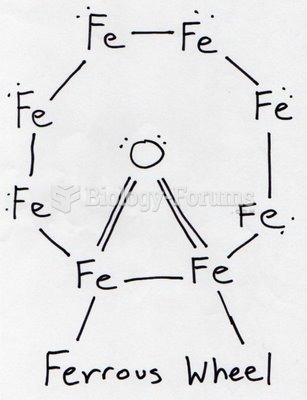Answer to Question 1
1
Rationale 1: Although taking iron with meals will lessen GI upset, food can decrease the absorption of iron by as much as 70. It is recommended that iron preparations be administered 1 hour before or 2 hours after a meal.
Rationale 2:Vitamin C increases the absorption of iron is incorrect because this statement is true.
Rationale 3:Antacids and food decrease the absorption of iron is incorrect because this statement is true.
Rationale 4:Calcium (including dairy products) and bran block ferrous sulfate's absorption is incorrect because this statement is true.
Global Rationale: Although taking iron with meals will lessen GI upset, food can decrease the absorption of iron by as much as 70. It is recommended that iron preparations be administered 1 hour before or 2 hours after a meal.
Answer to Question 2
1, 2, 4
Rationale 1: In the United States, deficiencies are most often the result of poverty, fad diets, chronic alcoholism, or prolonged parenteral feeding. Infants, pregnant women, nursing mothers, older adults, and those eating a vegan or vegetarian diet often require larger amounts of vitamins and minerals to maintain optimal health.
Rationale 2: In the United States, deficiencies are most often the result of poverty, fad diets, chronic alcoholism, or prolonged parenteral feeding. Infants, pregnant women, nursing mothers, older adults, and those eating a vegan or vegetarian diet often require larger amounts of vitamins and minerals to maintain optimal health.
Rationale 3: Deficiencies are most often the result of poverty, fad diets, chronic alcoholism, or prolonged parenteral feeding.
Rationale 4: In the United States, deficiencies are most often the result of poverty, fad diets, chronic alcoholism, or prolonged parenteral feeding. Infants, pregnant women, nursing mothers, older adults, and those eating a vegan or vegetarian diet often require larger amounts of vitamins and minerals to maintain optimal health.
Rationale 5: In the United States, deficiencies are most often the result of poverty, fad diets, chronic alcoholism, or prolonged parenteral feeding. Infants, pregnant women, nursing mothers, older adults, and those eating a vegan or vegetarian diet often require larger amounts of vitamins and minerals to maintain optimal health.
Global Rationale: In the United States, deficiencies are most often the result of poverty, fad diets, chronic alcoholism, or prolonged parenteral feeding. Infants, pregnant women, nursing mothers, older adults, and those eating a vegan or vegetarian diet often require larger amounts of vitamins and minerals to maintain optimal health. Controlled asthma and a history of smoking are not causes for vitamin deficiencies.







